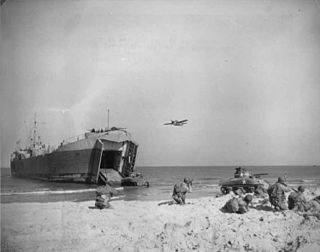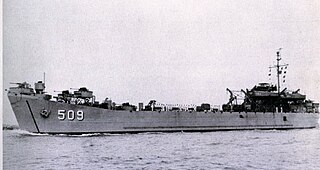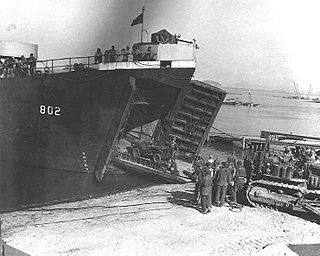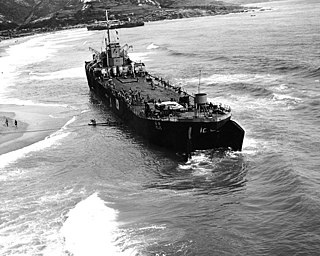USS ''LST-84'' was one of the hundreds of Tank landing ships built during World War II to support amphibious military operations. Her role was to carry significant quantities of vehicles, cargo, and troops directly onto an unimproved shore. The ship was sponsored by Mrs. W. Raymond Brendel. The ship was constructed inland at Jeffersonville, Indiana, by the Jeffersonville Boat & Machine Co. as coastal ship yards were used to build larger naval vessels. The ship traversed the Ohio and Mississippi River to reach open water.

USS Blessman (DE-69/APD-48), a Buckley-class destroyer escort of the United States Navy, was named in honor of Lieutenant Edward Martin Blessman (1907–1942), who was killed in action in the Pacific on 4 February 1942.

USS Hopping (DE-155) was a Buckley-class destroyer escort in service with the United States Navy from 1943 to 1947. In 1944, she was converted to a Charles Lawrence-class high speed transport and redesignated "APD-51". She was sold for scrap in 1966.

USS LST-209 was an LST-1-class tank landing ship built for the United States Navy during World War II. Like most of the ships of her class, she was not originally named, and known only by her designation. From June to August 1951 she served a stint as a part of the Military Sea Transportation Service (MSTS), manned by a civilian crew, and renamed USNS T-LST-209. She was recommissioned under her original name 24 August 1951, and renamed USS Bamberg County (LST-209) on 1 July 1955. She was named for Bamberg County, South Carolina, the only U.S. Naval vessel to bear the name.

USS Berkshire County (LST-288) was an LST-1-class tank landing ship built for the United States Navy during World War II. Named for Berkshire County, Massachusetts, she was the only U.S. naval vessel to bear the name.

USS Bulloch County (LST-509) was an LST-491-class tank landing ship built for the United States Navy during World War II. Named for Bulloch County, Georgia, she was the only U.S. Naval vessel to bear the name.

USS ARL-5 was one of 39 Achelous-class landing craft repair ships built for the United States Navy during World War II.

USS Caroline County (LST-525) was an LST-491-class tank landing ship built for the United States Navy during World War II. Named for counties in Maryland and Virginia, she was the only U.S. Naval vessel to bear the name.
USS LST-801 was an LST-542-class tank landing ship in the United States Navy. Like many of her class, she was not named and is properly referred to by her hull designation.
USS Curry County (LST-685) was an LST-542-class tank landing ship built for the United States Navy during World War II. Named after counties in New Mexico and Oregon, she was the only U.S. Naval vessel to bear the name.

USS Dodge County (LST-722) was an LST-542 class Landing Ship Tank, built for the United States Navy during World War II. She was renamed USS Dodge County on the first of July 1955, for counties in Georgia, Minnesota, Nebraska, and Wisconsin, and was the only United States Navy vessel to bear the name.

USS Greer County (LST-799) was a LST-542-class tank landing ship (LST) built for the United States Navy during World War II. She was named for Greer County, Oklahoma on 1 July 1955, and the only U.S. Naval vessel to bear the name.

USS Hamilton County (LST-802) was an LST-542-class tank landing ship built for the United States Navy during World War II. Named after counties in Florida, Illinois, Indiana, Iowa, Kansas, Nebraska, New York, Ohio, Tennessee, and Texas, she was the only U.S. Naval vessel to bear the name.

USS Harveson (DE-316) was an Edsall-class destroyer escort built for the U.S. Navy during World War II. She served in the Atlantic Ocean the Pacific Ocean and provided destroyer escort protection against submarine and air attack for Navy vessels and convoys.

USS LST-119 was a LST-1-class tank landing ship built for the U.S. Navy during World War II. She was designed to carry troops and military equipment to the shores of the battle front and quickly deliver her cargo. She served in the Pacific Ocean and post-war returned home with two battle stars to her credit.
USS LST-70 was an LST-1-class tank landing ship in the United States Navy. Like many of her class, she was not named and is properly referred to by her hull designation. LST-70 was manned by a United States Coast Guard crew throughout the Second World War.
USS Portunus (AGP-4) was an LST-1-class tank landing ship acquired by the U.S. Navy for use during World War II as a motor torpedo boat (MTB) tender. She was named after a Roman god of the sea, who had jurisdiction over ports and the shores.

USS LST-469 was a United States Navy LST-1-class tank landing ship used in the Asiatic-Pacific Theater during World War II. As with many of her class, the ship was never named. Instead, she was referred to by her hull designation.
USS Yolo (APB-43) was a Benewah-class self-propelled barracks ship of the United States Navy that served in the later years of World War II, and briefly post-war. She was struck in 1959, and scrapped in 1960.

USS LST-120 was a LST-1-class tank landing ship in the United States Navy during World War II. She was later transferred to the Republic of Korea Navy and renamed ROKS Munsan.















